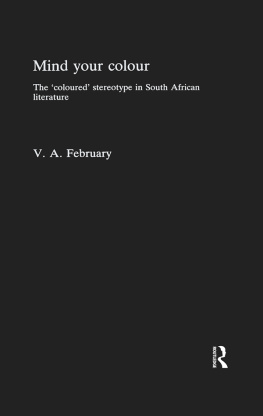The International Library of Sociology
COLOUR AND CULTURE IN SOUTH AFRICA
The International Library of Sociology
RACE, CLASS AND SOCIAL STRUCTURE
In 21 Volumes
I | The Changing Social Structure in England and Wales | Marsh |
II | Class in American Society | Reissman |
III | Class Structure in the Social Consciousness | Ossowski |
IV | Co-operative Communities at Work | Infield |
V | Co-operative Living in Palestine | Infield |
VI | Colour and Culture in South Africa | Patterson |
VII | The Deprived and the Privileged | Spinley |
VIII | The First Years of Yangyi Commune | Crook |
IX | The Functions of Social Conflict | Coser |
X | The Home and Social Status | Chapman |
XI | The Marginal Situation | Dickie-Clark |
XII | Negroes in Britain | Little |
XIII | Neighbours | Bracey |
XIV | The People of Ship Street | Kerr |
XV | Social Class, Language and Education | Lawton |
XVI | Social Mobility in Britain | Glass |
XVII | The Sociology of Colonies - Part One | Maunier |
XVIII | The Sociology of Colonies - Part Two | Maunier |
XIX | Stevenage | Orlans |
XX | Studies in Class Structure | Cole |
XXI | Working Class Community | Jackson |
COLOUR AND CULTURE IN SOUTH AFRICA
A Study of the Status of the Cape Coloured People within the Social Structure of the Union of South Africa
by
SHEILA PATTERSON
First published in 1953 by Routledge
Reprinted in 1998 by Routledge
2 Park Square, Milton Park, Abingdon, Oxon, OX14 4RN
Transferred to Digital Printing 2007
Routledge is an imprint of the Taylor & Francis Group
1953 Sheila Patterson
All rights reserved. No part of this book may be reprinted or reproduced or utilized in any form or by any electronic, mechanical, or other means, now known or hereafter invented, including photocopying and recording, or in any information storage or retrieval system, without permission in writing from the publishers.
The publishers have made every effort to contact authors/copyright holders of the works reprinted in The International Library of Sociology. This has not been possible in every case, however, and we would welcome correspondence from those individuals/companies we have been unable to trace.
British Library Cataloguing in Publication Data
A CIP catalogue record for this book is available from the British Library
Colour and Culture in South Africa
ISBN 0-415-17621-2
Class, Race and Social Structure: 21 Volumes
ISBN 0-415-17826-6
The International Library of Sociology: 274 Volumes
ISBN 0-415-17838-X
Publishers Note
The publisher has gone to great lengths to ensure the quality of this reprint but points out that some imperfections in the original may be apparent
ACKNOWLEDGEMENTS
It is unfortunately not possible to list individually the scores of people who have helped me so generously over the three and a half years during which this study was made and written up. I hope, however, that they will all accept this assurance of my sincere gratitude, for without their unstinted bestowing of time, interest and advice the work would never have been accomplished.
In particular I should like to express my appreciation to my husband, Bruce Tyrrell Patterson, who bore with me patiently during the whole period, Professor Raymond Firth, Professor Isaac Schapera, Dr. Kenneth Little, Dr. H. J. Simons, Professor J. S. Marais and Professor I. D. MacCrone, all of whom have read through the draft at various stages of its production, and have contributed invaluable suggestions and criticism.
SHEILA PATTERSON
Johannesburg
CHAPTER ONE
THE APPROACH
If any body shall reprove me, and shall make it apparent unto me, that in any either opinion or action of mine I doe erre, I will most gladly retract. For it is the truth that I seeke after, by which I am sure that never any man was hurt; and as sure, that he is hurt that continueth in any error, or ignorance whatsoever.MARCUS AURELIUS.
G UNNAR Myrdal, in the preface to An American Dilemma, gives his general terms of reference in the following passage:
The study, thus conceived, should aim at determining the social, political, educational and economic status of the Negro in the United States, as well as defining opinions held by different groups of Negroes and whites as to his right status. It must, further, be concerned with both recent changes and current trends with respect to the Negros position in American society. Attention must also be given to the total American picture with particular emphasis on relations between the two races. Finally it must consider what changes are being or can be induced by education, legislation, inter-racial efforts, concerted action by Negro groups, etc.
The execution of such a work required the co-operation of a large number of specialists in various branches of the social sciences over a considerable period of time. Any single-handed attempt to follow similar terms of reference, even in the smaller South African context, must therefore seem unduly ambitious. In the absence, however, of any large body of sociological literature on, or indeed of a general sociological survey of, the Cape Coloured People, it seemed advisable to make as wide a study as possible of this group within the framework of the larger society, even at the risk of superficiality.
After a brief historical sketch of the origins and formation of the Coloured People, the study does in fact follow the general pattern outlined by Myrdal,open-class system advocated by the American ideal, a system which is practised in the North and backed by the federal authorities.
In South Africa, there is no such internal disparity amongst various sections of the white community, all of whom, unlike Americans, live in close contact with coloured groups. There is a similar democratic ideal, but it is, in practice, reserved for Europeans only.







